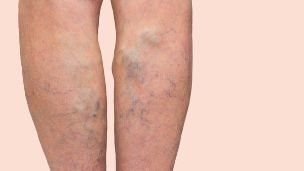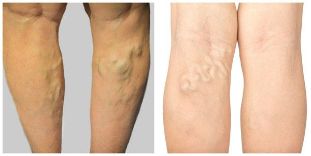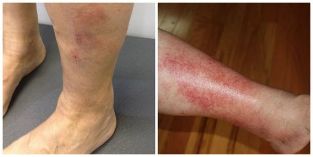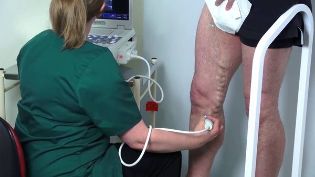The varicose disease or varicose veins of the lower extremities is the main varicose transformation of superficial veins of the lower extremities, which are the "bumps" or "sites" in the feet.

The varicose disease is very widespread throughout the world. Its frequency reaches 60% among the total adult population, depending on the country. It is interesting that the inhabitants of the african continent, and the asia-pacific region suffer from spider and varicose veins with much less frequency that the inhabitants of the european countries and the united states.
In relation to the lack of elements of the causes of varicose veins of the lower limbs to talk about your risk factors, that is to say, which increases the likelihood of developing this pathology is (property or characteristic of the human body, any impact on the body). Accepted by the majority of the risk factors of the disease considered to be age, female sex, obesity, and heredity. The typical "portrait" of a patient with the symptoms of varicose veins — a woman in the state of menopause, with an excess of a rating called body mass index, with more pregnancies and deliveries in the past.
The symptoms of varicose veins in the legs
In the great majority of cases, varicose disease can be recognized even not having special medical education. An objective symptom of the disease is the appearance of "pineapples" or "nodes" in the lower extremities, to the east of the epidermis above them generally are not different in any special color. The blue veins, as a general rule, are not a disease in its true sense, although they often bring to patients (often women) with certain inconveniences of the aesthetics of nature.
However, in cases of varicose veins can be accompanied by a color change of the skin resulting venous of the skin, which is manifested by a variety of spicy eruptions (blisters, painful nodules), and redness.
These signs, along with swelling of the legs, which does not disappear during a night of rest, indicate that the formation of chronic venous insufficiency.
As to the subjective symptoms of the varicose disease, it is worth noting its non-specificity. Complaints can indicate the disease, and may be a symptom of overload of the venous system of the lower extremities. Often patients are concerned about the weight, the feeling of extending the arms and not localized mild pain in the calf. Sometimes there are complaints of pain in the area of the varicose vein and an increase of the fatigue of the legs.
Burning sensation, tingling, muscle cramps during the night or restless legs syndrome (unpleasant sensations in the legs at rest, when it requires of its movement, to relieve this discomfort) is often found here in the pathology is neurological, for example, syndrome root, and should be taken into account with caution.
The pathogenesis of varicose veins in the legs
The pathogenesis of varicose veins of the lower extremities is fairly complex and versatile. The main role in the development of the disease has a lesion in the wall and valves of the veins. As a result of your incorrect operation, the system generates the return current of blood (reflux), and then occurs the defeat of the endothelium (the inner lining of the vessel), which is accompanied by inflammation.
Later in the process include average, and the interior of the layers of the venous wall: there is a proliferation of the connective tissue in the muscle layer of vienna, and then of his atrophy, which leads to the progressive destruction of the collagen skeleton of the ship. These phenomena violate elasticheskie the properties of vienna, contribute to a greater expansion of your light and spiral tightening length. At the same time these changes are observed in the venous valves.
It should be noted that visible as the "bumpy" and "sites" are often a result of the invisible presence of the source of varicose veins — great saphenous vein. In the great majority of cases, is large, less small subcutaneous vienna. This change in the basin of the veins and lead to varicose disease.
Complications of varicose veins in the legs
The complications of the varicose disease is must be a trophic of the violation (venous ulcers), thrombosis of esophageal varices modified of the veins (thrombophlebitis) bleeding and not to "pineapples" and "nodes".
Trophic violations are the result of the progression of the disease in the absence of treatment, often go years and decades. Start them with skin manifestations — and hyperpigmentation (brown spots), venous eczema and lipodermatosclerosis (joints, skin).
The main location of these changes — leg, although venous eczema can be seen in the scope of any varicose veins, even in the hip. Depending on the source of varicose veins (great or small veins saphenous) trophic disorders has been either by the inner or by the outer surface of the lower third of the leg, respectively. The result of the eating disorders of soft tissues serves education of the venous ulcer at the site of the changes. The ulcers are solitary or multiple, with false contours, smooth edges and flat, smooth background. It is observed scarce separate, often character-purulent. The appearance of the sores are accompanied by itching and pain. For venous ulcers of the legs is to emphasize long-life (months) and the frequent repetition.

Thrombophlebitis or thrombosis of superficial veins should not be confused with thrombosis of the deep veins. In the second case, the situation is much more serious. However, and in the thrombotic defeat of the varicose vein symptomatology is very unpleasant. In the field of thrombosis of vienna is painful form like a seal, for him, characterized by redness, local rise of temperature and increase of the sensitivity, sometimes the seal limits the movement of the limbs. The clinical picture most closely resembles the ulcer or abscess.
Thrombophlebitis can be especially dangerous if you will take the ascending nature and will pass with the superficial system to the deep. In this case, it may happen as pulmonary embolism and deep vein thrombosis.
The bleeding of the esophageal varices advanced of the veins are very alarming, because due to the high venous pressure jet of blood is strong. In some cases, this can cause a krovopotere.
The diagnosis of varicosities of the veins in the legs
The diagnosis of varicose veins of the lower extremities usually does not cause special difficulties. A key feature of the disease is the existence of venous thrombotic events "pineapples" and/or "sites". Although if you are overweight, the development of the subcutaneous fat of the lower extremities, is difficult.
To further confirm the diagnosis apply different methods of instrumental diagnosis, the main of which is the ultrasound duplex scanning (USD). Allows you to quickly, accurately and securely determine the origin of varicose veins, to estimate the dimensions and the structure of the glass, the function of the venous valves, the scale of distribution of the return current of blood and to detect the presence of blood clots. At the same time look around and deep and surface as the system. The research is due to the standing position or, if the patient's condition does not allow, seated with the cast toward the legs. Study in the supine position can lead to mistakes in the definition of reflux and blood clots.
To obtain the evaluation of the function of the valves and the extension of the return current of the blood applied:
- compression of the samples of pressure, to different segments of the lower extremities;
- the sample with the effort (sample of Valsalva);
- the imitation of walk;
- reception of paraná — lightweight attempt to refer the patient to a state of balance with the end of the so-called tension of the muscles of the calf.
The total number of duplex ultrasound study of the veins of the lower extremities, should be set in the form of opinion and of the graphic image, drawing a map "venous". The results of the research have their invaluable help in the planning of the continuity of the treatment. However, it should be taken into account in conjunction with the clinical data, as changes of ultrasound from the work in the absence of objective evidence of disease (varicose veins) should be considered as functional (i.e., not related to the pathology is of the veins). It's also worth noting that ultrasound scanning is not necessary, if the diagnosis is clear, and if the patient does not have plans of treatment of the varicose disease is.
There are complementary methods of diagnosis:
- doppler — The Doppler (not to be confused with the USD).
- plethysmography;
- radiopaque venography;
- radiovenografía;
- the computed tomography (ct);
- magnetic resonance imaging (mri);
- the thermal image;
- intravascular ultrasound (IVUS) — new method.

The treatment of varicose veins of the veins in the legs
The main goal of treatment of varicose veins of the lower extremities is the removal of all the evil workers of the veins. This is only possible through invasive. Distinguish three forms:
- Removal combined phlebectomy, short Peel, minila phlebectomy, the dissection of the perforation veins;
- "Adherence" — sclerotherapy, mechanochemical obliteration, cyanoacrylate fuming obliteration;
- "Brewing" — endovenous laser or radiofrequency obliteration.
To achieve the goal of treatment it is necessary to perform two tasks: resolve the source of varicose veins (so-called vertical reflux) and remove the esophageal varices varicose veins. For a long time, more often the method of extraction of follicular units combined phlebectomy. Its technical implementation consists of two steps:
- Tubal anastomosis — points of the junction of the great saphenous vein with the common femoral vienna (crossectomy);
- The removal of the trunk of the great saphenous vein with the help of the probe (Stripping).
This is a different intervention raditude and has a number of significant deficiencies, inherent in any operation: the frequent need for the narcosis of dispensary, the presence of incisions and sutures, tangible the rehabilitation period and the increase, in comparison with other methods, the risk of complications.
However, about twenty years ago, there has been a "phlebology the revolution". This has been possible thanks to the widespread introduction of ultrasound and the appearance of the elegant methodology — endovenous thermal obliteration. Its essence consists in the influence of the high temperature in the wall of the vein in the inside. This is achieved by using laser radiation (EVLO) or of exposure to radio frequencies (OMR), "saarialho" the lumen of the vein.
Vienna in doing so, it immediately stops its operation and then gradually are reabsorbed. In this manner, without cuts, fast, efficient, safe, and attractive to the hearing in order to resolve vertical reflow, without need for future rehabilitation. As a prominent representative of the bureau of surgery, endovenous thermal obliteration more than ten years already and is considered the best method of treatment of the varicose disease in the world.
Sclerotherapy (paste affected of vienna through the introduction in particular of the substance) has also found wide application in the solution of varicose veins. However, to achieve the desired result requires a careful selection of patients due to an increased risk of recurrence of the disease.
Conservative treatments, including compression therapy, phlebotrophic medicines and local pharmaceutical dosage forms (gels, ointments), are of a purely accessory, influencing mainly the symptoms of varicose veins, do not deal with its origin.
Prognosis. The prevention of the
Taking into account the current methods of treatment, the outcome in varicose veins favorable. Even in the circumstances and, apparently, running the cases of removal of esophageal varices transformed veins and leads to the improvement of the condition of the patient.
However, in treatment planning it is very important to make an assessment of your risk, since any intervention of all modes is in itself the potential adverse effects. The first duty of a doctor to reduce their likelihood. Before any manipulation should be discussed with the patient at all times relative to the intervention and to obtain their signature on the informed consent.
All events are adverse can be divided into the risks associated with their intervention, in particular, and with the anesthesia, and the risks for the patient.
The risks of surgery can be small, for example, inflammation (phlebitis) in "developed" or sklerozirovanie veins of the legs, accompanied by a stamp in your projection and moderate tolerance to the pain syndrome. Can appear as patches of skin with low sensitivity, and hyperpigmentation of the skin. All these phenomena are temporary and usually go quite fast, without any effect.
Major complications are thrombosis of the deep veins, allergic and toxic reactions to anesthesia medications. We are here on very rare occasions, however, for the patient, which occurred such a complication, the case is 100%, even though the statistics in 1 case for every 10,000 operations.

Prevention of venous thrombosis is mainly based on the counting of the risks of the so-called scale points system with the use of the table of Caprini. It contains in itself all the different risk factors, which have gradation. The accounting of each factor and the total excretion of points determines the degree of risk and its prevention. The main means of prevention of venous thromboembolic disease complications of the following:
- minimization of the trauma of the operation;
- the activation early of the patient;
- close knit items;
- pharmacological prevention, that is to say, the mapping of the indications of anticoagulants — blood thinners.
And in regard to the prevention of the varicose disease is, then, simply does not exist, because until now it is not clear what is the main cause of the pathology is, which could have an impact and therefore prevent the onset of the disease. Related to this are and are quite frequent recurrences of varicose veins after any type of intervention. However, taking into account all the advantages a minimally-invasive treatment, this is not a significant problem. Keep your feet on the order simply a main time of visit, taking into account























